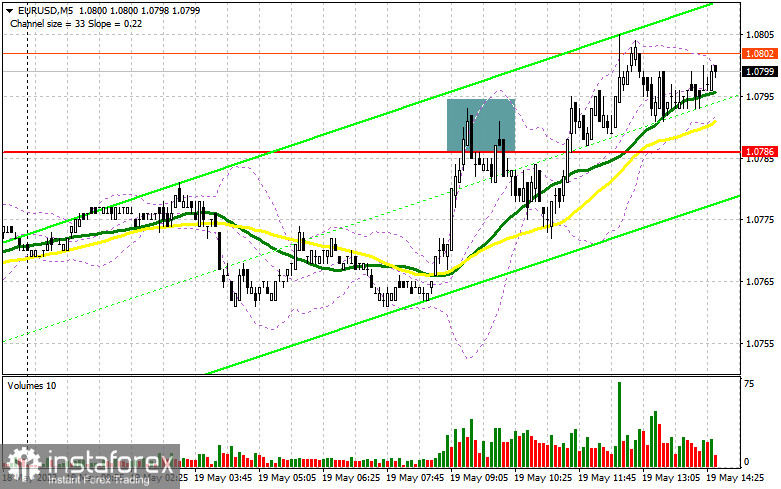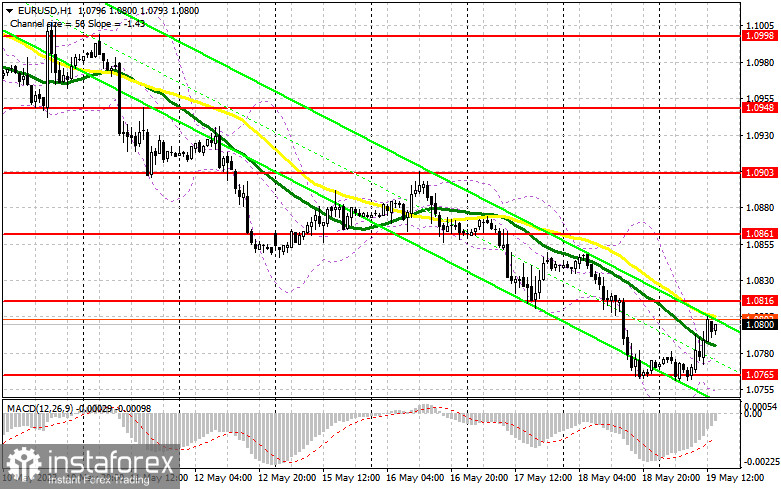In my morning article, I turned your attention to 1.0786 and recommended making decisions with this level in focus. Now, let's look at the 5-minute chart and figure out what actually happened. A rise and a false breakout of 1.0786 gave a sell signal. After moving down by 15 pips, the bearish pressure eased. Investors did not want to sell at the current swing lows. For this reason, the technical outlook was slightly revised for the afternoon.

When to open long positions on EUR/USD:
As the economic calendar remains empty and trading volumes are low, some speculators opened long positions on the euro, especially after Germany's Producer Price Index significantly exceeded economists' forecasts. In the afternoon, traders are looking forward to the statements of Fed Chairman Jerome Powell as well as John Williams and Michelle Bowman. They will hardly say anything new. So, the upward correction may continue at the end of the week.
Only a false breakout of the weekly low of 1.0765 as well as neutral remarks of Fed policymakers could lead to an increase in EUR/USD to the resistance level of 1.0816. Below this level, the moving averages are passing in negative territory. A breakout and a downward retest of this level will boost demand for the euro, creating new entry points into long positions. The pair may climb to a high of 1.0861. A more distant target will be the 1.0903 level where I recommend locking in profits. If bears make another attempt to regain control and bulls show no activity at 1.0765 in the afternoon, the bearish trend will persist. Therefore, only a false breakout of the support level of 1.0716 will provide new entry points into long positions. You could buy EUR/USD at a bounce from 1.0674, keeping in mind an upward intraday correction of 30-35 pips.
When to open short positions on EUR/USD:
Sellers refrain from opening new short positions. However, only a few traders are willing to buy the euro at swing lows. In the event of a further upward correction after the comments of Fed policymakers, beers will have to defend the resistance level of 1.0816. A false breakout of this level will give a sell signal that may push the pair down to 1.0765. Consolidation below this level as well as an upward retest could trigger a fall to a new monthly low of 1.0716. A more distant target level will be a low of 1.0674 where I recommend locking in profits.

If EUR/USD rises during the American session and bears show no energy at 1.0816, bulls could try to return to the market. In this case, I would advise you to postpone short positions until a false breakout of 1.0861. You could sell EUR/USD at a bounce from a high of 1.0903, keeping in mind a downward intraday correction of 30-35 pips.
COT report
According to the COT report (Commitment of Traders) for May 9, there was a rise in long and short positions. This report takes into account the changes that have taken place in the market after the Fed and ECB meetings. The majority of traders are increasing long positions on the euro. A new downward correction which already occurred last week will provide a buy signal. The euro needs new strong drivers to start a correction. Given that there are no important reports this week and only a few speeches from Fed officials, the pressure on the pair may continue. The COT report indicates that long non-commercial positions jumped by 13,503 to 260,335, while short non-commercial positions advanced by 7,570 to 80,913. At the end of the week, the total non-commercial net position increased to 179,422 against 173,489 a week earlier. The weekly closing price declined to 1.0992 against 1.1031.

Indicators' signals:
Trading is carried out below the 30 and 50 daily moving averages, which indicates a strong bearish sentiment.
Moving averages
Note: The period and prices of moving averages are considered by the author on the H1 (1-hour) chart and differ from the general definition of the classic daily moving averages on the daily D1 chart.
Bollinger Bands
If EUR/USD rises, the indicator's upper border at 1.0800 will serve as resistance.
Description of indicators
- Moving average (moving average, determines the current trend by smoothing out volatility and noise). Period 50. It is marked yellow on the chart.
- Moving average (moving average, determines the current trend by smoothing out volatility and noise). Period 30. It is marked green on the chart.
- MACD indicator (Moving Average Convergence/Divergence - convergence/divergence of moving averages) Quick EMA period 12. Slow EMA period to 26. SMA period 9
- Bollinger Bands (Bollinger Bands). Period 20
- Non-commercial speculative traders, such as individual traders, hedge funds, and large institutions that use the futures market for speculative purposes and meet certain requirements.
- Long non-commercial positions represent the total long open position of non-commercial traders.
- Short non-commercial positions represent the total short open position of non-commercial traders.
- Total non-commercial net position is the difference between the short and long positions of non-commercial traders.
 English
English 
 Русский
Русский Bahasa Indonesia
Bahasa Indonesia Bahasa Malay
Bahasa Malay ไทย
ไทย Español
Español Deutsch
Deutsch Български
Български Français
Français Tiếng Việt
Tiếng Việt 中文
中文 বাংলা
বাংলা हिन्दी
हिन्दी Čeština
Čeština Українська
Українська Română
Română

